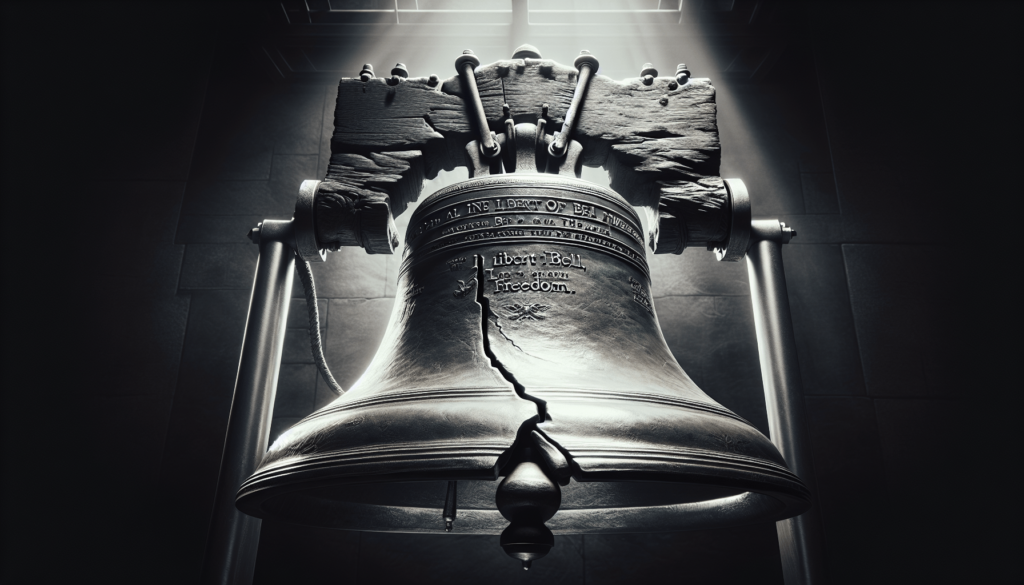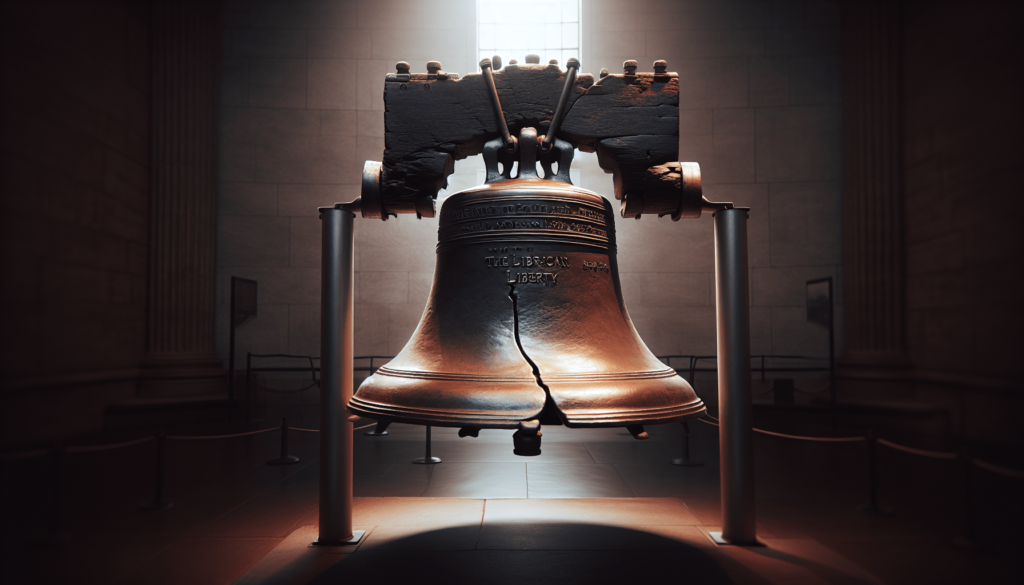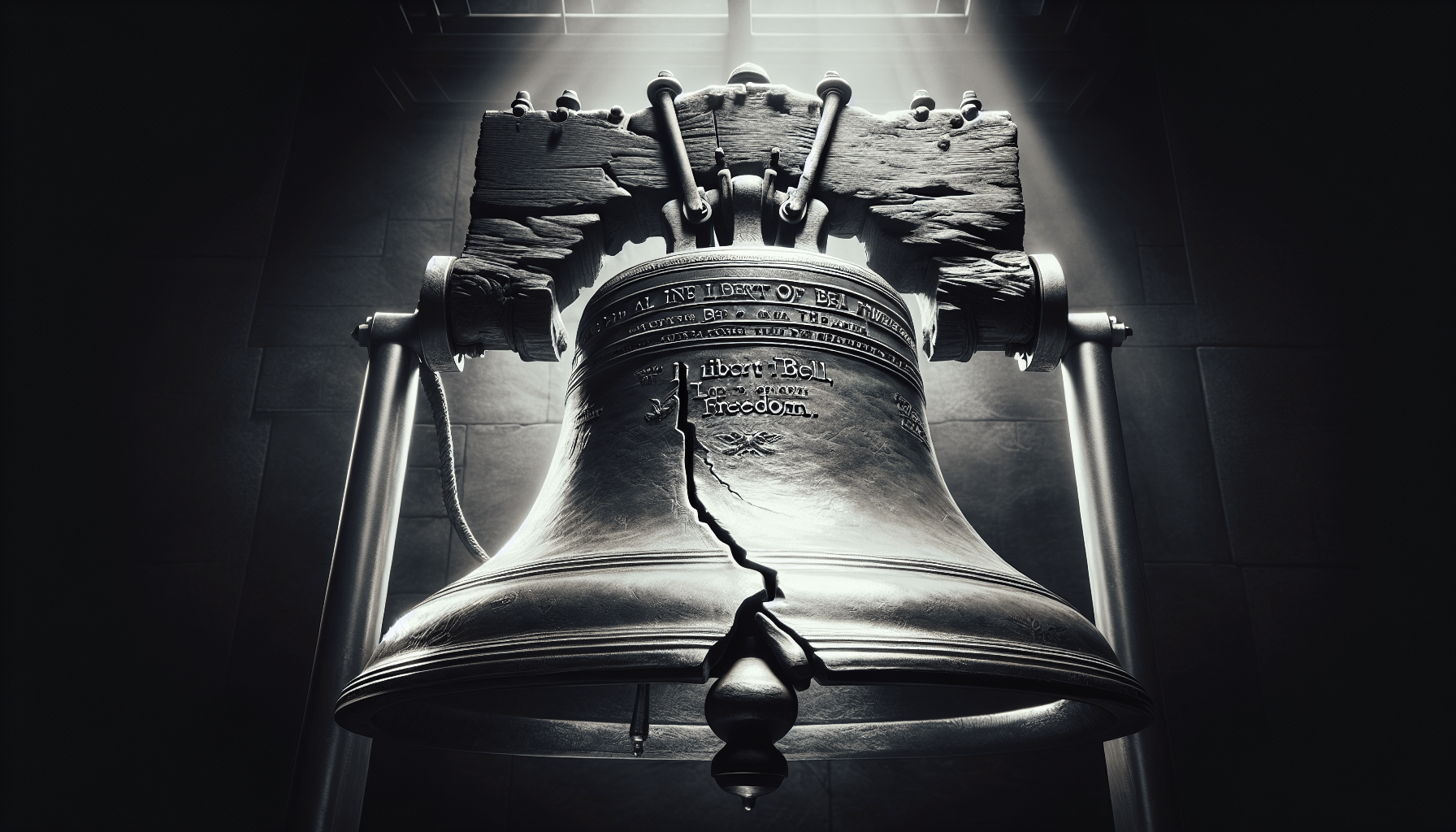Travelers Club Chicago Hardside Expandable Spinner Luggage, Black, 20" Carry-On
$36.54 (as of April 7, 2025 11:41 GMT +00:00 - More info)Step back in time and immerse yourself in the rich history of the iconic Liberty Bell. Uncover the story behind this symbol of American independence, as you delve into its fascinating past. From its origins in London to its infamous crack, this article will take you on a journey through centuries, offering a glimpse into the power and significance of this hallowed artifact. Join us on an exploration of the Liberty Bell’s history, as we uncover the secrets and tales that have shaped its legacy.

Origins of the Liberty Bell
Casting of the Bell
The Liberty Bell, one of America’s most iconic and cherished symbols of freedom, has a rich and fascinating history. The bell was cast in 1752 by the Whitechapel Bell Foundry in London, England, and was originally intended as a replacement for the failed State House bell. The casting of the Bell was a significant event, as it marked the beginning of a symbol that would come to represent the ideals of liberty and independence for generations to come.
Initial Use
After its arrival in Philadelphia, the Liberty Bell was hung in the tower of the Pennsylvania State House, which is now known as Independence Hall. The bell’s first official use was to summon lawmakers to legislative sessions and to alert citizens of important public announcements. It quickly gained recognition for its clear and resonant sound, earning its reputation as a bell of significance and distinction.
Cracking of the Bell
The exact cause of the Liberty Bell’s famous crack is still debated among historians and bell enthusiasts. Some believe that a flaw in the original casting led to the crack, while others attribute it to years of extensive use and exposure to harsh weather conditions. Regardless of the cause, the bell developed a significant crack in the early 19th century, rendering it unringable. Rather than repairing the bell, it was retired and began its journey towards becoming a cherished symbol of freedom.
Symbolism and Significance
Bell as a Symbol of Freedom
The Liberty Bell’s symbolism lies in its association with the American ideals of liberty and freedom. It resonated with the American people during a time of revolution and struggle for independence from British rule. The bell’s inscription of the biblical verse from Leviticus, “Proclaim liberty throughout all the land unto all the inhabitants thereof,” further solidified its symbolic value as a beacon of hope and freedom.
Role in American History
Throughout American history, the Liberty Bell has played a significant role in defining and representing the ideals of the nation. It became a powerful symbol during the American Revolution, inspiring patriots and serving as a rallying cry for independence. The bell’s significance continued into the 19th century, where it became a symbol for the abolitionist movement and later the civil rights movement. The Liberty Bell stands as a constant reminder of the long journey towards freedom and equality.
Legends and Stories
The Liberty Bell’s fame and significance have led to the creation of numerous legends and stories surrounding its history. One popular legend tells of how the bell rang out to announce the signing of the Declaration of Independence on July 4, 1776. While this story is not historically accurate, it demonstrates the lasting impact the bell has had on the American psyche. Other tales include stories of repairing the bell’s crack with silver, and the tradition of bringing the bell on tour to inspire patriotic fervor during times of war.
Relocation and Conservation
Transfer to Independence Hall
After its retirement as a functioning bell, the Liberty Bell was transferred to the ground floor of Independence Hall and put on display for the public to view. This move marked a new era for the bell, transitioning it from an active instrument to a revered historical artifact. Independence Hall provided a fitting home for the bell, as it was the birthplace of the Declaration of Independence and the United States Constitution.
Damage and Repairs
Over the years, the Liberty Bell has sustained further damage to its already cracked structure. In 1846, a chunk of approximately four feet in length broke off during a public celebration. This damage only added to the bell’s mystique and solidified its status as a cherished relic. Several attempts were made to repair the bell, but none were successful in restoring its full functionality.
Preservation Efforts
Recognizing the importance of preserving this national treasure, comprehensive efforts have been made to ensure the Liberty Bell’s longevity. In the early 20th century, the National Park Service took over the care and conservation responsibilities for the bell. Today, a team of experts is dedicated to preserving the bell, utilizing state-of-the-art technology and techniques to stabilize and protect it for future generations to appreciate and admire.
Public Display and Accessibility
Exhibition in Liberty Bell Center
To make the Liberty Bell more accessible to the public, a dedicated visitor center called the Liberty Bell Center was built adjacent to Independence Hall. The center houses the bell in a climate-controlled environment and provides visitors with an up-close and personal view of this iconic symbol of freedom.
Viewing Opportunities
Visitors to the Liberty Bell Center have the opportunity to view the bell from several angles and distances, allowing them to appreciate its craftsmanship and historical significance. The bell is displayed in an open space, allowing visitors to gather and reflect on its profound meaning. The center also offers interpretation and informational displays, educating visitors about the history and impact of the Liberty Bell.
Interactive Exhibits
To further engage visitors and deepen their understanding of the Liberty Bell, the Liberty Bell Center features interactive exhibits that bring history to life. These exhibits use multimedia presentations, artifacts, and hands-on activities to provide a contextual and immersive experience. Visitors can explore the bell’s role in American history, learn about the people who fought for freedom, and even try their hand at ringing a replica bell.

The Inscription and Its Meaning
Quotation from Leviticus
The Liberty Bell’s inscription, “Proclaim Liberty Throughout All the Land Unto All the Inhabitants Thereof,” is taken from the biblical book of Leviticus (25:10). The use of this verse was not accidental but rather a deliberate choice to emphasize the importance of liberty and freedom as fundamental human rights. The inscription speaks to the universal desire for freedom and the belief that it should be extended to all people, regardless of background or circumstances.
Interpretation and Inspirational Message
The inscription on the Liberty Bell serves as a powerful reminder of the enduring struggle for freedom and equality. It inspires individuals to embrace the ideals of liberty and to advocate for justice and fairness for all. The inscription’s message goes beyond the historical context of the bell’s creation and continues to resonate with people today, serving as a call to action for a more inclusive and equitable society.
Historical Significance and Impact
Declaration of Independence
The Liberty Bell’s association with the signing of the Declaration of Independence has elevated its historical significance. While it did not actually ring on that momentous occasion, the bell has become forever intertwined with the founding principles of the United States. It symbolizes the courage and determination of the Founding Fathers and their vision of a nation built on liberty and self-governance.
Abolitionist Movement
During the 19th century, the Liberty Bell took on a new significance as it became a symbol for the abolitionist movement. Abolitionists saw the unfulfilled promise of freedom inherent in the inscription on the bell and used it to rally support for the eradication of slavery. The bell served as a powerful symbol of hope and a reminder of the unfinished work towards achieving equality for all.
Civil Rights Movement
In the 20th century, the Liberty Bell once again played a crucial role during the civil rights movement. The bell became a symbol of inspiration for leaders such as Dr. Martin Luther King Jr., who saw the struggle for civil rights as a continuation of the fight for justice and equality that the bell represented. The Liberty Bell served as a powerful call to action, encouraging individuals to fight for the rights and freedoms of all people.
Visiting and Experiencing the Liberty Bell
Planning Your Visit
To fully appreciate the significance of the Liberty Bell, it is recommended to plan your visit in advance. Check the operating hours and visitor guidelines of the Liberty Bell Center, as it can get quite busy, especially during peak seasons. Consider arriving early in the day to avoid long lines and ensure ample time to explore the exhibits and learn about the bell’s history.
Guided Tours
For a more immersive experience, consider joining a guided tour of the Liberty Bell. Knowledgeable guides provide valuable insights into the bell’s history and its symbolism. They can answer questions and provide a deeper understanding of the historical events and movements associated with the Liberty Bell.
Interactive Experiences
Make the most of your visit to the Liberty Bell Center by taking advantage of the interactive experiences offered. Engage with multimedia presentations, artifacts, and educational displays that provide a deeper understanding of the bell’s historical significance. Take the opportunity to participate in hands-on activities, such as trying your hand at ringing a replica of the bell, to fully immerse yourself in the experience.
Associated Landmarks and Attractions
Independence Hall
While visiting the Liberty Bell, be sure to explore the nearby Independence Hall. As the birthplace of the Declaration of Independence and the United States Constitution, the building holds immense historical significance. Take a guided tour of Independence Hall to witness where the founding principles of the nation were drafted and debated, and gain a deeper understanding of the events that shaped American history.
National Constitution Center
Located just a short distance from the Liberty Bell, the National Constitution Center provides further insight into the history and impact of the United States Constitution. Explore interactive exhibits, engaging multimedia presentations, and interpretive displays that highlight the significance of the Constitution in shaping the nation’s governance and democracy.
Old City Historic District
Extend your visit to the Liberty Bell and explore the vibrant Old City Historic District. This neighborhood is home to numerous other historic sites, museums, and landmarks that offer a glimpse into America’s past. Take a stroll through the cobblestone streets and immerse yourself in the rich history, charming architecture, and diverse culinary scene that make this district a must-visit destination.
Interesting Facts and Trivia
Weight and Dimensions
The Liberty Bell weighs approximately 2,080 pounds and measures 12 feet in circumference. It stands at just over three feet tall, making it a significant and imposing object. The bell’s size and weight contribute to its grandeur and the impact it has had on American history.
Different Names
Contrary to popular belief, the Liberty Bell was not always known by its current name. It was initially referred to as the “State House Bell” due to its location in the Pennsylvania State House. Over time, it became associated with the ideals of liberty and freedom, earning the name “Liberty Bell” through public sentiment and historical significance.
Reproduction Bells
In addition to the original Liberty Bell, there are several authorized reproductions of the bell that can be found across the United States. These reproduction bells serve as reminders of the original’s symbolism and can be seen in various locations, including state capitols and historical sites. While not the original bell itself, these reproductions continue to inspire and educate visitors about the values it represents.
Digital Resources and Online Exhibits
Virtual Tours and Exhibitions
For those unable to visit the Liberty Bell Center in person, there are virtual tours and online exhibitions available. These digital resources allow individuals to explore the bell’s history, symbolism, and significance from the comfort of their own homes. Virtual tours provide an immersive experience, incorporating high-resolution images, audio guides, and interactive elements to create an engaging and educational online visit.
Archival Photographs and Videos
To further delve into the history and impact of the Liberty Bell, archival photographs and videos provide a glimpse into its past. These resources offer a visual timeline of the bell’s journey, showcasing its various locations, restoration efforts, and moments of public celebration. Archival materials provide a unique perspective on the bell’s story and allow for a deeper appreciation of its cultural and historical value.
In conclusion, the Liberty Bell’s origins, symbolism, and historical significance make it a truly remarkable and important artifact of American history. From its casting and initial use to its relocation and preservation efforts, the bell’s journey has been one of resilience and enduring significance. Its inscription and message continue to inspire and guide individuals in the pursuit of freedom and equality. Visiting the Liberty Bell is a chance to encounter a tangible piece of history, immerse oneself in its rich stories and legends, and reflect on the struggles and successes that have defined the United States.







